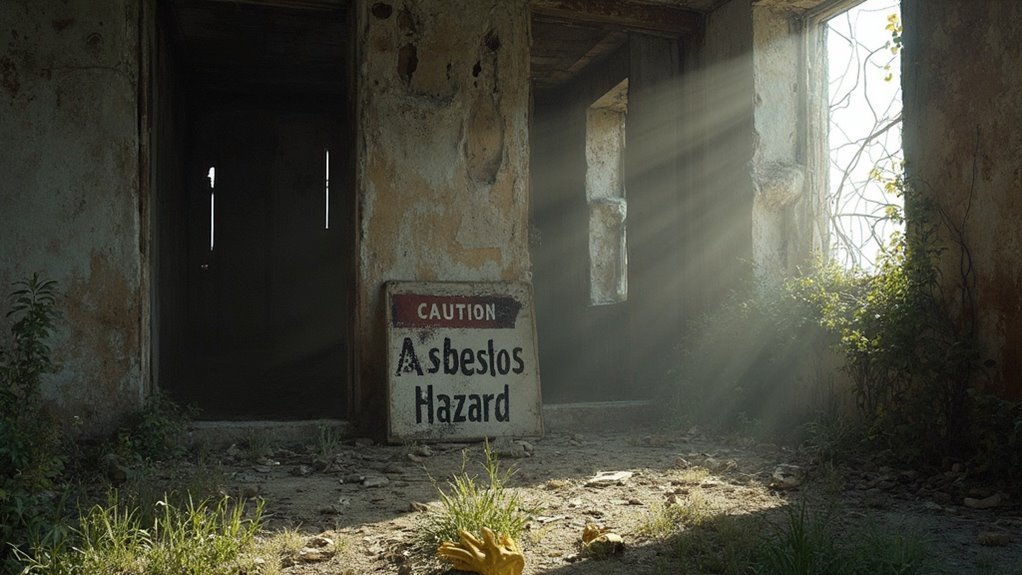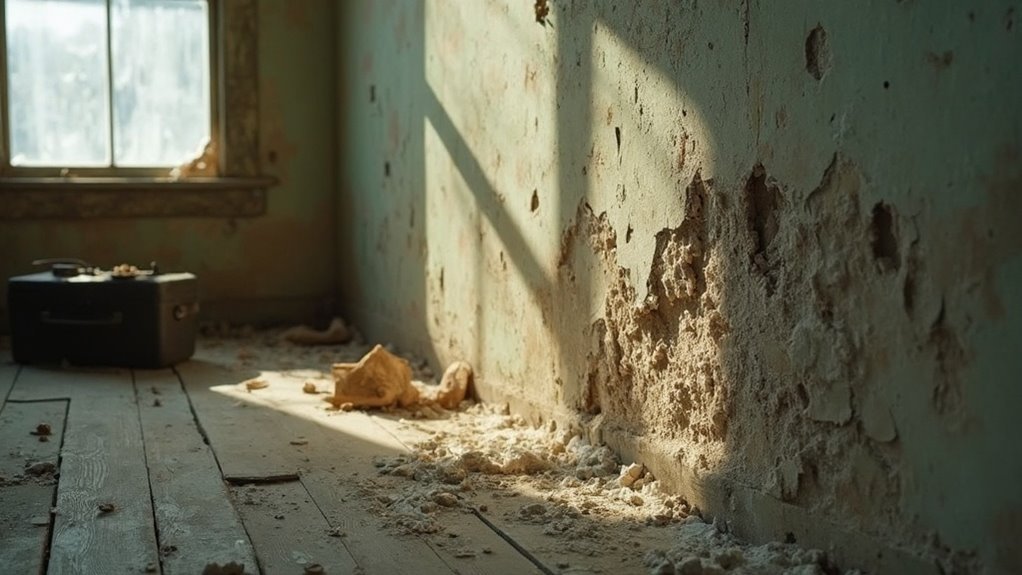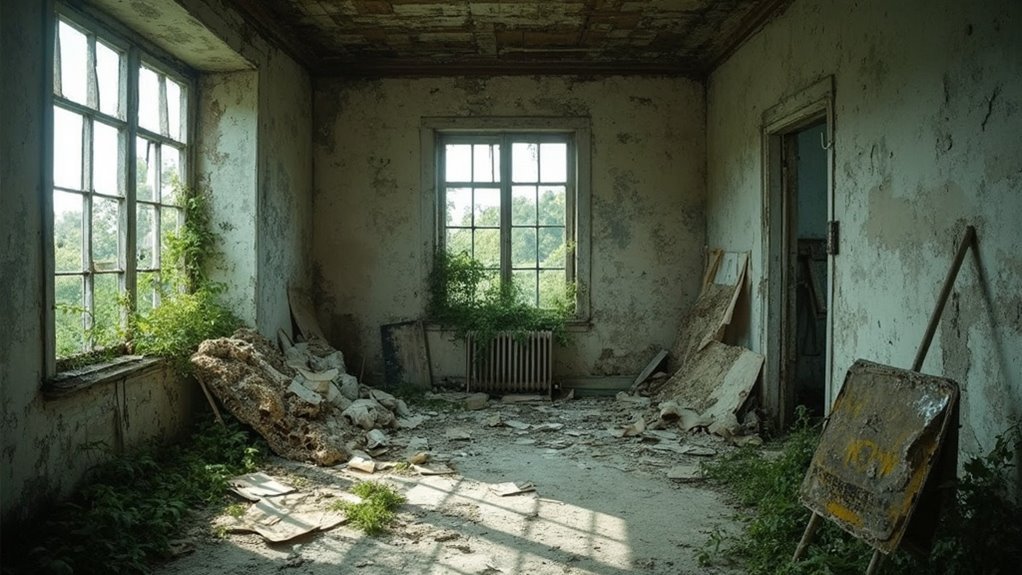Your home could be at serious risk from asbestos, especially if it was built before 2004. Common materials like insulation, floor tiles, and roofing may contain asbestos fibers that can harm your health if disturbed. Prolonged exposure can lead to serious diseases, including asbestosis and mesothelioma. It's essential to have a professional inspection to identify any asbestos-containing materials and assess their condition. Regular inspections and proper removal are important steps to mitigate risks and guarantee your home is safe. Understanding these factors can help you make well-informed choices about your home's safety and health compliance.
Understanding Asbestos in Homes

Asbestos in homes poses significant risks, especially in older properties. Understanding where asbestos can be found is vital for effective asbestos identification and ensuring safety. Common insulation types containing asbestos include attic insulation made from vermiculite, pipe insulation in basements, and duct insulation around heating and cooling systems. You may likewise encounter asbestos in boiler and furnace insulation within utility rooms.
In addition to insulation, various building materials in your home may contain asbestos. Roof shingles, cement siding shingles, and vinyl asbestos tiles are notable examples. Older linoleum or laminate flooring, along with wood parquet mastic, may additionally pose risks. If these materials remain undisturbed and intact, they aren't an immediate threat. Conversely, disturbing them can release harmful fibers into the air. Fibers released during product use can significantly increase the risk of exposure, making awareness of these materials essential. Asbestos exposure can lead to serious health issues, emphasizing the importance of proper management and testing.
To accurately identify asbestos, you should engage a trained and accredited asbestos professional. They can safely collect samples for lab analysis. Remember, improper handling or removal can increase exposure risks. It's vital to trust these tasks to experts who can navigate the complexities of asbestos removal, protecting both your health and your property's value.
Health Risks of Asbestos Exposure
Exposure to asbestos can lead to severe health complications, making it imperative to understand the associated risks. Asbestos-related diseases often develop after prolonged exposure, with symptoms manifesting anywhere from 10 to 50 years later. Common asbestos symptoms include shortness of breath, persistent cough, and chest pain, which can escalate into more severe conditions like asbestosis, lung cancer, and mesothelioma.
Asbestosis involves scarring of lung tissue, causing considerable respiratory issues, while lung cancer arises from long-term irritation caused by trapped asbestos fibers. Mesothelioma, though rarer, is an aggressive cancer affecting the lining of critical organs. Identifying asbestos in older buildings is crucial to prevent exposure and mitigate health risks.
Understanding the exposure duration is fundamental, especially for those in high-risk occupations such as construction and firefighting. If you or someone you know has been exposed, be vigilant about early signs. Recognizing asbestos symptoms early can greatly improve treatment outcomes. Regular health monitoring is important, particularly for individuals with a history of exposure. Remember, awareness and prompt action are your best defenses against the severe health risks posed by asbestos.
Global Impact of Asbestos

Amid ongoing discussions about health risks, the global impact of asbestos remains notable, affecting economies and public health worldwide. Countries like Kazakhstan and Russia continue to dominate asbestos production and trade, with Kazakhstan exporting over 269,000 metric tons in 2023 alone. In spite of many nations, including the U.S. and over 60 others, imposing bans, India remains the largest importer of asbestos products. This contradiction complicates global trade dynamics and showcases the challenges in regulating this hazardous material.
The economic impact of asbestos exposure is profound. Studies reveal that asbestos-related illnesses lead to billions in productivity losses annually, greatly burdening healthcare systems. For instance, the UK estimates that asbestos-related deaths cost the economy £3.4 billion each year. These losses extend beyond individual families, affecting industries and entire national economies.
Interestingly, research from the WHO indicates that banning asbestos doesn't have negative economic repercussions. Instead, it can encourage innovation in safer materials, leading to long-term economic benefits. While the immediate costs of asbestos removal can be high, the shift to safer alternatives ultimately promotes healthier work environments and boosts property values, ensuring a sustainable economic future.
The Need for Professional Removal
When dealing with hazardous materials like asbestos, the necessity of professional removal cannot be overstated. Many homeowners fall victim to asbestos myths, believing they can safely remove it themselves. Nevertheless, the risks associated with self-removal are significant. Without the proper equipment and professional training, you increase your exposure to dangerous asbestos fibers, which can lead to severe health issues, including cancer. Additionally, improper handling can spread contamination to other areas of your home.
Hiring professionals guarantees that the removal process adheres to legal regulations and safety protocols. These experts possess the necessary training and certifications, allowing them to handle asbestos safely and effectively. They use specialized equipment to contain and remove the material, minimizing health risks and guaranteeing thorough cleanup and proper disposal.
Furthermore, professional removal gives you peace of mind, knowing that your home is free from lingering asbestos hazards. By choosing qualified experts, you protect not only yourself but also your family and future occupants from the hidden dangers of asbestos exposure. Prioritizing professional removal is an essential step in safeguarding your home and health.
Safe Practices for Asbestos Management

When managing asbestos, a professional inspection is essential to identify potential risks accurately. Regular monitoring of asbestos-containing materials guarantees that any changes in condition are detected early, minimizing exposure risks. By prioritizing these practices, you can maintain a safer environment for everyone involved.
Professional Inspection Required
Professional inspection is vital in managing asbestos safely, especially in buildings constructed before 2004, which are more likely to contain hazardous materials. To guarantee thorough assessments, it's imperative to engage inspectors who meet state and federal qualifications. These professionals adhere to strict inspection standards that require visual inspections to identify suspect materials like popcorn ceilings, along with material sampling to analyze fiber properties.
The inspection process includes various dust sampling methods, such as scraping and micro-vacuum techniques, with samples sent to accredited laboratories for accurate analysis. Regulatory frameworks, like those from the EPA, recommend testing materials that appear damaged or deteriorating. In some regions, like Oregon, mandatory asbestos surveys are required before any demolition or renovation activities.
Inspectors provide detailed reports outlining the condition of any asbestos-containing materials (ACM), including their location and recommended response actions. These reports must be thorough, documenting the inspector's credentials, project details, and analysis results. By prioritizing professional inspections, you can guarantee that any potential asbestos risks are effectively managed, keeping your home safe and compliant with relevant regulations.
Regular Monitoring Essential
Regular monitoring of asbestos-containing materials (ACMs) is vital for guaranteeing the safety of building occupants and maintaining compliance with health regulations. By implementing effective monitoring strategies, you can conduct regular inspections and air quality testing, helping detect potential asbestos issues early. This proactive approach allows for prompt action to manage any risks associated with ACMs.
Establish a thorough maintenance plan that includes routine asbestos testing to assess the condition of the materials. Regular inspections not only prevent future exposure risks but also guarantee that you meet all regulatory requirements. If you identify any deterioration or damage, you'll be able to take action before it becomes a larger issue.
Moreover, prepare for potential abatement by identifying the scope of work and developing a detailed plan. Secure necessary permits and guarantee that all safety protocols are followed. By doing so, you create a safer environment for everyone involved.
In essence, regular monitoring is a vital component of asbestos management. It cultivates a culture of safety and compliance while minimizing risks to building occupants. Prioritize these practices to safeguard health and maintain peace of mind.
Importance of Regular Inspections
Regular inspections are crucial for the early detection of asbestos-containing materials, which can greatly reduce health risks. By implementing preventative health measures through these inspections, you can protect both workers and occupants from potential exposure. Professional inspections guarantee that any asbestos issues are identified and managed effectively, keeping your environment safer.
Early Detection Benefits
Conducting timely inspections is vital for identifying asbestos in buildings before it becomes a serious health hazard. Regular asbestos testing utilizes advanced detection technologies to pinpoint the presence of asbestos, allowing you to address any issues swiftly. Early detection greatly reduces health risks, preventing asbestos-related illnesses that can lead to costly medical treatments.
Furthermore, by identifying asbestos early, you can avoid expensive renovation disasters that arise from accidental exposure during construction. It likewise guarantees compliance with regulatory standards, safeguarding you from potential legal liabilities associated with non-compliance.
Property owners benefit from improved property value, as asbestos-free buildings are more marketable and appealing to buyers. Regular inspections not only identify the presence of asbestos but also guide your decisions on whether encapsulation, enclosure, or removal is necessary, guaranteeing safe maintenance of your property.
Preventative Health Measures
Routine inspections are crucial in maintaining a safe environment when it comes to asbestos management. They serve as a cornerstone of preventive strategies designed to identify potential hazards before they escalate into serious health risks. For buildings with known asbestos-containing materials (ACMs), regular checks every six to twelve months can make a significant difference. During these inspections, you should assess the condition of ACMs using visual evaluations and maintain detailed records, such as photos or videos, to track any changes over time.
Factors like building age, occupancy levels, and planned renovations can influence how often you need to conduct these inspections. By educating yourself and occupants about the potential presence of asbestos, you empower everyone to recognize signs of wear and tear on materials, promoting a proactive approach to safety. Training maintenance workers for routine surveillance checks not only improves safety but additionally integrates health education into your preventive measures.
Professional Inspection Necessity
When it comes to asbestos management, the necessity of professional inspections cannot be overstated; they play a pivotal role in guaranteeing safety and compliance. Regular asbestos inspections are vital as they help identify hidden hazards in your home, such as insulation, tiles, and roofing materials that may contain asbestos. Licensed professionals conduct extensive asbestos testing, following strict safety protocols to minimize risks during the process.
During an inspection, experts sample various areas of your property and send these samples to accredited labs for analysis. This thorough approach guarantees accurate identification of asbestos-containing materials (ACMs), which is fundamental for developing effective removal methods. The findings are compiled into a detailed report outlining the location, type, and condition of identified ACMs, along with management recommendations.
Statistics on Asbestos-Related Illnesses

Asbestos exposure remains a significant public health concern, with staggering statistics highlighting its deadly impact. You may be surprised to learn that 85% of mesothelioma cases in men and 23% in women are linked to workplace exposure. From 1940 to 1980, approximately 27 million American workers faced asbestos exposure, and today, around 1.3 million still do. The median time from first exposure to death from malignant mesothelioma is about 32 years, illustrating the long-term consequences of this hazardous material.
In terms of disease prevalence, asbestos-related deaths are alarming. By 2005, long-term exposure led to 18,068 American deaths. Estimates suggest that an additional 29,667 lives could be lost to asbestos-related diseases between 2005 and 2027. Each year, 12,000 to 15,000 Americans die from these conditions, and between 1999 and 2013, mesothelioma accounted for 39,870 deaths.
Globally, asbestos-related diseases caused 107,000 deaths in 2004 alone. With these asbestos statistics, it's clear that the risks are extensive, making awareness and proactive measures crucial for safeguarding your health.
Regulatory Measures and Bans
The alarming statistics surrounding asbestos-related illnesses underscore the urgent need for thorough regulatory measures to mitigate exposure risks. Regulatory compliance is vital in maneuvering the complex framework of federal, state, and local regulations surrounding asbestos. Key federal laws, such as the National Emission Standards for Hazardous Air Pollutants (NESHAP) and the Asbestos Hazard Emergency Response Act (AHERA), set stringent guidelines for managing asbestos in schools and during renovations.
Some states, like Ohio and California, have adopted even more stringent regulations, guaranteeing that asbestos emissions are effectively controlled and that proper procedures are followed for identification and handling. These regulations mandate thorough inspections before any demolition or renovation work and require notifications to relevant agencies, emphasizing the importance of compliance.
Moreover, the Toxic Substances Control Act defines asbestos and restricts its uses, contributing to ongoing asbestos bans. Understanding these regulations is vital for homeowners and property managers alike, as adherence not only protects public health but also guarantees legal compliance. By prioritizing regulatory measures and understanding the bans in place, you can notably reduce the risks associated with asbestos exposure in your environment.
Frequently Asked Questions
How Can I Identify Asbestos-Containing Materials in My Home?
To identify asbestos-containing materials in your home, conduct asbestos testing on insulation, roofing, flooring, and ceiling textures. Look for older materials, especially those from before the 1980s, as they're more likely to contain asbestos.
What Should I Do if I Suspect Asbestos Presence?
If you suspect asbestos presence, prioritize safety precautions. Arrange for professional asbestos testing through accredited labs, ensuring qualified analysts handle samples. Avoid disturbing materials, and consult experts for effective remediation to minimize health risks.
Are There Safe Alternatives to Asbestos Removal?
"Better safe than sorry" applies when considering asbestos alternatives. Safe remediation methods like encapsulation and enclosure reduce risks while managing asbestos effectively, often proving more cost-effective and less disruptive than full removal.
How Often Should I Have My Home Inspected for Asbestos?
You should schedule asbestos inspections based on home safety guidelines, particularly before renovations or if your home shows signs of damage. Regular inspections every few years can help guarantee your home remains safe from asbestos-related risks.
What Costs Are Associated With Professional Asbestos Removal?
Like peeling an onion, asbestos removal costs depend on several factors. Area size, asbestos type, location, prep work, and testing all influence the total expense, typically ranging from $1,192 to $3,255 for complete removal.
